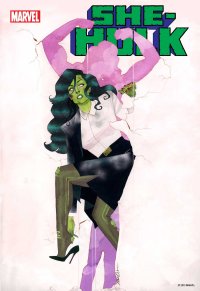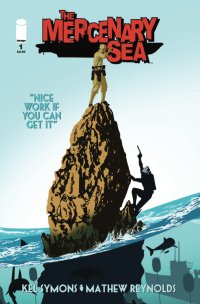She-Hulk #1 (Marvel Comics, $2.99)
By Devon Sanders
Sometimes, you get something you didn’t know that you wanted anymore.
Due to Marvel’s seeming hellbent to make Red She-Hulk a thing, I’d sort of given up on seeing the best and greenest of She-Hulks, Jennifer Walters, returned to prominence.
I’ve loved and followed the character of The She-Hulk for years. From her replacing The Thing in John Byrne’s 80’s Fantastic Four to her own Byrne-driven 90’s solo series to Dan Slott’s excellent millennial series, She-Hulk has been a favorite of mine. This character has been a part of my reading for over 30 years.
I love this character.
She-Hulk #1, a comic book, much like my favorite Marvel character, is comprised of intelligence and beauty; returning to the comics stands, whatever way you read digitally and to prominence.
Writer Charles Soule, a practicing lawyer, smartly engages the reader with the hurdles She-Hulk has to go through in the world of law and quickly shows you why facing down Galactus, in so many ways, is preferable to the hurdles thrown up by a billionaire’s team of lawyers who fully know the power of his dollar and his brand.
Soule showcases She-Hulk’s can-do individuality while firmly establishing that as a member of The Avengers and The Fantastic Four families, she’s more than earned her status as one of Marvel’s most connected and needed superheroes.
Artist Javier Pulido is, in my opinion, the perfect choice for this comic. Pulido’s She-Hulk just fills up every panel she’s in, giving her grace and poise in her lawyerly duties while reminding the reader that she can be savage, when necessary. Pulido is a master of facial expression, having her go from wild-eyed enthusiasm to weariness, perfectly servicing the needs of the script. In short, he just gets this character and I look forward to more.
In She-Hulk #1, we’re given an intriguing mix of Law & Order and well, nothing I’ve ever seen before. If this comic were called “Law & Order: She-Hulk Division”, I’d be ok with that but it’s truly something different and in so many ways, better.
It smartly lets law become a character within the story without resorting to sensationalism. No small feat but one worthy of She-Hulk.
Rating: 




Out of a Possible 5 Stars
 Nobodies #1 (Ascendant, $1.99, but you can read it for free on the book’s website)
Nobodies #1 (Ascendant, $1.99, but you can read it for free on the book’s website)
By Cat Taylor
Although this is a new digital comic through Comixology.com, this issue has been around for over a year through other sources. It is certainly an ambitious first issue for an independently produced comic. The good part of that is that there are a lot of avenues to explore and plenty of places future issues can go. The bad part is that sometimes cramming in too much too early can lose people and create a lot of continuity problems and plot holes down the road. The ambitious scope of the series is evident on the first page, which is an all-prose page written as a letter from the current President of the United States explaining the recent world apocalypse, known as the Rapture, how he came to assume the office of President, and how the world’s currency and main recreation is now marijuana. However, with the exception of the aftermath of the Rapture, none of this is referenced at all in the actual story in this first issue of the comic. Therefore, the whole introductory page is superfluous at this point. It’s not even necessary to explain the Rapture, because the story’s protagonist, Iggy, serves as a surrogate for the reader and the readers learn everything about the new state of the world as Iggy learns them. The only insight we, as readers, have to the new world that Iggy doesn’t is the information from the president’s letter and that information doesn’t figure in to the events of this first issue.
The actual story begins with Iggy waking up in a hospital bed in a warehouse, not knowing what has happened or how the world got the way it is. If this sounds familiar, it’s because that’s also how 28 Days Later and The Walking Dead both started. I don’t know what it is with starting post-apocalyptic stories with the “waking up from a coma” plot point but that’s not the only similarity that the Nobodies shares with those properties. There are also tribes/factions that have formed from the survivors who battle with each other to maintain control of their areas and to protect their resources, and there’s also the Nobodies. The Nobodies aren’t exactly zombies but they aren’t all that different either. The main difference that is revealed in the first issue is that they don’t seem to be a threat. So, they’re pretty much what zombies would be if they never attacked anyone and weren’t infectious. To most of the characters in this issue, the Nobodies are treated like children treat the toys they’ve grown tired of. However, they seem to serve some use to at least one of the factions because they keep them around to study and for who knows what else? Of course, this is all horrifying to Iggy who doesn’t understand how people can have so little regard for other human beings.
The artwork in the first issue by Ger Curti has an easy-to-follow narrative flow and the panels have a good sense of perspective. So, Ger is clearly a competent artist, but the details in his/her work are sketchy, like it was rushed. In addition, since the art is all black and white, the greyscaler, Ariel Iacci, serves the purpose of the colorist. In this case, Ariel’s work with the grey scales really stands out. It’s critical in a detailed black and white comic to have greys that communicate details without looking flat or muddy and that is fortunately achieved here.
While the plot and the events in the first issue don’t seem to be very original, the writer, John Vinson, at least has a good sense of pacing and story structure. I wonder how far ahead he’s planned, because with the amount of threads he’s dangled this early things could really unravel, but it’s also possible that he has some interesting ends already in the works and this will all lead to exciting journeys.
Rating: 




Out of a Possible 5 Stars
The Mercenary Sea #1 (Image, $3.99)
By Jeb D.
In our current pop culture moment, we’ve seen a slew of recent (mostly) TV shows using the exotic settings, costumes, and characters of the past to tell stories characterized by anachronistic 21st century perspective on issues of race, class, and gender: The Borgias, The Musketeers, Black Sails, and the gloriously stupid DaVinci’s Demons. And while writer Kel Symons and artist Matthew Reynolds set The Mercenary Sea in a pulp world not far removed from, say, Terry and the Pirates, there’s enough contemporary PC here to give Milt Caniff an aneurism.
Captain Jack Harper is a classic pulp adventurer, a tough ex-bootlegger who, in 1938, is leading the usual ragtag group of mismatched soldiers of fortune, including a Brit, a German, and a Frenchman, along with a “spunky” young female mechanic, in search of a fairly typical MacGuffin: “the lost island of Koji Ra”. The first issue runs the usual expository playbook, as Jack lays out the quest to his team, but with a twist, as pulp trope after pulp trope gets deconstructed: for instance, the dark-skinned aboriginals in their National Geographic dress aren’t the chanting cannibals of, say, King Kong (a film which, in a bit of metatextual fun, is evidently one of the chief’s favorites), but rather articulate types who enjoy sitting down with some popcorn to enjoy a Marx Brothers movie on a screen set up in a jungle clearing. Nearly every member of the cast comes supplied with an explanation as to why they’re more than just a typical pulp stereotype (the crew’s willing to tolerate the presence of the baseball-capped Samantha as a “suffragette;” Jack’s a scoundrel, but objects to pirates, etc.). On the one hand, I suppose, it does give Symons something to offer beyond the bare bones of introducing yet another Indiana Jones-style artifact hunt, but he carries it off with a self-consciousness that pulls the reader out of the story now and again as he insists on reminding us that he’s not trafficking in offensive or outdated adventure story clichés; all well and good, but better if you can manage to do so without drawing attention to the fact that you’re doing it.
What really sets The Mercenary Sea apart from the usual Doc Savage/Phantom knockoff adventure is Reynolds’ artwork, which I suspect is going to be both a strong selling point, and a complete deal-breaker, depending on the reader. I’ve seen it described as looking like a series of classic painted cells from an animated movie, and that’s an accurate description of the clean lines and color blocking; there’s some occasional awkwardness in the Photoshopping, but for the most part the basic technique is workable. He has a real fondness for scenes of silhouetted figures in the foreground set against a lush gradient (azure skies, deep orange sunsets, etc.), and even if the trick gets repetitive, he does achieve some striking effects. But a good pulp adventure depends less on mood or aesthetics, and more on the kineticism of the action; so far, his work on that score seems a bit stiff and muted. Mind you, Symonds hasn’t really given him much to do along those lines in this first issue (save one quick barroom brawl), so there’s the chance that he’ll come up with something a bit more dynamic in future issues. For now, though, it’s his technique which, in a love-it-or-leave-it way is the most distinctive aspect to this book, and the principal reason to check it out.
Rating: 




Out of a Possible 5 Stars
 Novelty Song #1 (Bee Tee Dee, $1.99)
Novelty Song #1 (Bee Tee Dee, $1.99)
By Cat Taylor
Even though the comic book field is dominated by costumed heroes, and the next tier of comic book stories are about non-costumed heroes (war comics, crime comics, horror comics, science fiction comics, etc.) there are still a good number of unlauded comic books about other stuff. Most of these are from underground or independent publishers and most of those are happening in the digital format nowadays. Novelty Song is one of those books. Finding a book like Novelty Song is like finding the proverbial needle in a haystack. There are so many digital comics being produced with little fanfare that word-of-mouth is extremely important. That’s one of the reasons why I chose to review this book. Another reason is because I spent about ten years of my young adult life performing in underground music groups. So, I could identify with a lot of the material in this story. I’m pretty sure the writer/artist, Bee Tee Dee is a musician himself given how dead-on some of this material is. Anyone who has ever been in a local band will be introduced to a number of familiar scenarios of watching a local bar band in the first few pages, from lengthy four band bills (“Fuck, another band?!“), really dumb band gimmicks (Paul Simon tribute with an all extra-terrestrial backing band), to watching one of your old bands perform with your replacement (“He wrote his own lyrics to MY songs?“). I don’t know how much someone who has never been in a band will identify with these scenes, but then again, I don’t know if anyone who hasn’t been in a band will even be interested in this comic book.
As I read this issue, the little things were detailed enough that I thought this would be a comic series similar to Hate!, Eightball, Love and Rockets or any of those other cool independent comics that tell human stories and manage to make the ordinary interesting. While Novelty Song showed tremendous potential to do that, there is a major plot point of fantasy fiction that is introduced in this issue. This supernatural element addresses the concept that every music fan/musician goes through when they say, “Man, I wish I had written that song.” It appears that this is going to be a “be careful what you wish for” situation, as this issue has already addressed some of the reasons why few cover bands can perform a great song as well as the original artist (“Nuances! Where are the nuances?!“).
One of the impressive things about this comic is that Bee Tee Dee does everything. He/she is the writer, publisher, and artist. Of the three, the writing is where the issue is the strongest. The artwork is reminiscent of the art that accompanies a lot of children’s books, cartoony without a lot of detail, stiff characters, and static imagery. Fortunately, this isn’t an action/adventure comic because I don’t see any evidence that Bee Tee Dee could pull off that kind of artwork. However, it’s a fitting style for this kind of story.
I’m not sure how far a story like this can go with the supernatural songwriting element they’ve introduced. I imagine the characters are going to end up trying to undo the inevitable damage they’ve caused before it’s all over, just like with most cat’s paw wishes in other fables. However, the main fantastic wish-fulfillment element is actually secondary to the other concepts of the story in my opinion. Meanwhile, the real guiding forces that will keep things interesting to me are the humor, the characters, and their underground music scene. As long as those remain strong, this will likely remain a good series.
Rating: 




Out of a Possible 5 Stars